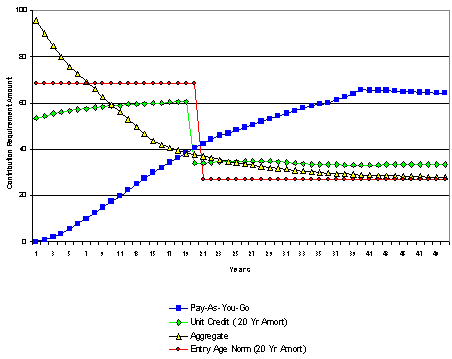
Overview Information
on
Current Status of Minnesota Public Pension Plans,
Funding Problems of the Minneapolis Teachers
Retirement Fund Association,
and
Review of Actions in Other States to Solve
Pension Funding Problems
Materials on Minnesota Public Pension Plans, MTRFA, and the Experience of Other States With Problem Pension Plans
Growth and Development of Minnesota Public Pension Plans (Pages 5-6);
Establishment of Minnesota Public Pension Plans (Pages 7-10);
Types of Pension Plans (Page 11);
Minnesota Defined Benefit Plans and Defined Contribution Plans (Page 12);
Major and Statewide Minnesota Public Pension Plans: Plan, Fund and Administration (Page 13);
Nature of Actuarial Funding (Page 14);
Pattern of Recognizing Pension Costs Over Time Under Various Funding Methods (Page 15);
Actuarial Reporting on Minnesota Public Pension Plans (Page 16);
Actuarial Valuation Results: Summary for All Plans (Page 17);
Actuarial Valuation Results: Statewide General Employee Plans Summary (Page 18);
Actuarial Valuation Results: Statewide Public Safety Plans Summary (Page 19);
Actuarial Valuation Results: Local Police and Paid Fire Plans Summary (Page 20);
Actuarial Valuation Results: Statewide Specialty Retirement Plans Summary (Page 21);
Actuarial Valuation Results: First Class City Retirement Plans Summary (Page 22);
Actuarial Valuation Results: Teacher Retirement Plans Summary (Page 23);
Funding Ratios Over Time: PERA-General, MSRS-General, and TRA (Page 24);
Funding Ratios Over Time: TRA, MTRFA, and SPTRFA (Page 25);
Normal Cost Over Time: PERA-General, MSRS-General, and TRA (Page 26);
Normal Cost Over Time: TRA, MTRFA, and SPTRFA (Page 27);
Employee and Employer Contributions Over Time: PERA-General, MSRS-General, and TRA (Page 28);
Employee and Employer Contributions Over Time: TRA, MTRFA, and SPTRFA (Page 29);
Total Requirements vs. Total Support Over Time: PERA-General, MSRS-General, and TRA (Page 30);
Total Requirements vs. Total Support Over Time: TRA, MTRFA, and SPTRFA (Page 31);
Minnesota Public Pension Plans: Funding Progress 1957-2003 (Page 32);
Minnesota Public Pension Plans: Actuarial Experience Gains and Losses 1986-2003 (Pages 33-35);
The Retirement Plan Watch List (Page 36);
Actuarial Value of Pension Plan Assets Compared to Market Value
Relationship of Current Assets to Market Value of Assets (Page 37);
- Deferred Asset Losses That Will Be Recognized July 1, 2004 (Page 38);
- July 1, 2003, Actuarial Accrued Liability Funding Ratios (Page 39);
- 2003-2004 Contribution Sufficiency/(Deficiency) Measures (Page 40);
Minnesota Public Pension Plan Demographics (Page 41-47);
Public Pension Plan State Aid (Page 48-50);
Administrative Expenses Over Time: PERA-General, MSRS-General, and TRA (Page 51);
Administrative Expenses Over Time: TRA, MTRFA, and SPTRFA (Page 52);
Various Minnesota Public Pension Funds: Total Portfolio Time-Weighted Rates of Investment Return (Page 53);
Approaches to Address Public Pension Plan Funding Problems: Minnesota (Page 54); and
Historic Purposes for a Pension Benefit Plan
A pension benefit plan is part of the overall personnel compensation system of the employer.
A pension benefit plan must assist the other parts of the personnel system.
Within the confines of affordability, the pension benefit plan should assist the employing unit in the following:
the recruitment of new qualified personnel;
the retention of existing qualified and productive personnel; and
the encouragement of predictable and systematic out-transitioning of personnel at the end of their normally expected working career.
The pension benefit plan accomplishes this assistance by providing pension benefits that are adequate to provide retiring employees with financial security at and after the date of retirement.
The emphasis of a pension benefit plan will vary over time. During the early decades of this century, retention of personnel was the major emphasis for pension benefit plans. Over time, recruitment has gained greater emphasis. During recent periods of downsizing, out-transitioning has been emphasized to a greater extent by both employees and employers.
The Commissionís Principles of Pension Policy, last substantively revised in 1996, provide that:
Minnesota public pension plans exist to augment the Minnesota public employer's personnel and compensation system by assisting in the recruitment of new qualified public employees, the retention of existing qualified public employees, and the systematic out-transitioning of existing public employees at the normally expected conclusion of their working careers by providing, in combination with federal Social Security coverage, personal savings and other relevant financial sources, retirement income that is adequate and affordable.
Minnesota public pension plans should play their appropriate role in providing financial security to public employees in retirement.
As Minnesota public employee workforce trends develop, Minnesota public pension plans should be sufficiently flexible to make necessary adaptations.
Growth and Development of Minnesota Public Pension Plans
Earliest Minnesota public pension plan was the Minneapolis Fire Departmental Relief Association, established in 1868.
All Minnesota public pension plans established before 1900 were public safety plans (except firefighters relief associations, including the Duluth and St. Paul fire plans, and one police relief association, the Minneapolis Police Relief Association).
Minnesota public pension plans were created on patchwork basis, generally covering uncovered groups rather than reorganizing existing plan coverage.
First general employee retirement plans were teacher retirement plans (Duluth Teachers Retirement Fund Association (DTRFA) in 1910, Minneapolis Teachers Retirement Fund Association (MTRFA) in 1910, St. Paul Teachers Retirement Fund Association (SPTRFA) in 1910, and the Teachers Insurance and Retirement Fund in 1915).
First statewide retirement plans were the Teachers Insurance and Retirement Fund in 1915, the State Employees Retirement Association (now MSRS-General) in 1929, and the Public Employees Retirement Association (PERA) in 1931.
First retirement plan to default was the Teachers Insurance and Retirement Fund. Plan was replaced by the Teachers Retirement Association (TRA) in 1931.
Latest retirement plans were established in 1999 (State Fire Marshal Arson Investigator Retirement Plan and the local Government Correctional Retirement Plan).
|
1860ís |
1 |
1930ís |
11 |
|
1870ís |
0 |
1940ís |
23 |
|
1880ís |
3 |
1950ís |
11 |
|
1890ís |
6 |
1960ís |
12 |
|
1900ís |
6 |
1970ís |
3 |
|
1910ís |
8 |
1980ís |
5 |
|
1920ís |
2 |
1990ís |
2 |
Some retirement plans have been closed to new entrants, with replacement coverage (Minneapolis Employees Retirement Fund (MERF), Minneapolis Teachers Retirement Fund Association (MTRFA)-Basic Program, St. Paul Teachers Retirement Fund Association (SPTRFA)-Basic Program, Duluth Teachers Retirement Fund Association (DTRFA)-Old Law Program, Minneapolis Firefighters Relief Association, Minneapolis Police Relief Association, Fairmont Police Relief Association, Virginia Fire Department Relief Association).
Many retirement plans have been merged into another plan:
Game Wardens Retirement Plan and State Police Retirement Plan into State Patrol Retirement Plan;
County and Probate Court Judges Retirement Plan, District Court Judges Retirement Plan, and Supreme Court Justices Retirement Plan into Uniform Judicial Retirement Plan;
Attorney General Retirement Plan and State Auditor Retirement Plan into Elected State Officers Retirement Plan;
Supreme Court Clerk Retirement Plan into MSRS-Unclassified Employees Retirement Plan;
48 local police or paid firefighter relief associations into PERA-P&F.
Establishment of Minnesota Public Pension Plans
|
Statewide Pension Plans |
Establishment Date |
|
General State Employees Retirement Plan (MSRS-General) |
1929 |
|
Correctional Employees Retirement Plan (MSRS-Correctional) 1 |
1973 |
|
Game Wardens Retirement Plan 2 |
1955 |
|
State Police Retirement Plan 3 |
1961 |
|
State Patrol Retirement Plan |
1943 |
|
Legislators Retirement Plan 4 |
1965 |
|
Attorney General Retirement Plan 5 |
1953 |
|
State Auditor Retirement Plan 5 |
1955 |
|
Elective State Officers Retirement Plan (ESO) 53 |
1967 |
|
Supreme Court Justices Retirement Plan 6 |
1943 |
|
District Court Judges Retirement Plan 6 |
1949 |
|
Probate and County Court Judges Retirement Plan 6 |
1931 |
|
Uniform Judicial Retirement Plan 54 |
1973 |
|
Supreme Court Clerk Retirement Plan 7 |
1953 |
|
Military Affairs Department Personnel Retirement Plan 8 |
1980 |
|
Transportation Department Pilots Retirement Plan 8 |
1982 |
|
State Fire Marshal Division Arson Investigator Retirement Plan 8 |
1999 |
|
Unclassified State Employees Retirement Program (MSRS-Unclassified) 9 |
1971 |
|
Metropolitan Transit Commission-Transit Operating Division Retirement Plan 10 |
1944 |
|
Public Employees Retirement Plan (PERA-General) |
1931 |
|
Public Employees Police and Fire Retirement Plan (PERA-P&F) 11 |
1959 |
|
Local Government Correctional Employees Retirement Plan 12 |
1987/1999 |
|
PERA Defined Contribution Retirement Plan 13 |
1987 |
|
University of Minnesota Police Retirement Plan 14 |
1969 |
|
Teachers Insurance and Retirement Plan 15 |
1915 |
|
Teachers Retirement Plan (TRA) |
1931 |
|
State University and Community College Supplemental Retirement Plan |
1965 |
|
Individual Retirement Account Plan (IRAP) 16 |
1988 |
|
|
|
|
Local General Employee Pension Plans |
|
|
Minneapolis Employees Retirement Plan (MERF) 17 |
1919 |
|
St. Paul Bureau of Health Relief Association 18 |
1919 |
|
Hennepin County Supplemental Retirement Plan 19 |
1969 |
|
Duluth Teachers Retirement Plan (DTRFA) 20 |
1910 |
|
Minneapolis Teachers Retirement Plan (MTRFA) 20 |
1910 |
|
St. Paul Teachers Retirement Plan (SPTRFA) 20 |
1910 |
|
|
|
|
Local Police and Salaried Firefighters Pension Plans |
|
|
Albert Lea Firefighters Relief Association 21 |
1895 |
|
Albert Lea Police Relief Association 22 |
1943 |
|
Anoka Police Relief Association 23 |
1948 |
|
Austin Firefighters Relief Association 24 |
1909 |
|
Austin Police Relief Association 49 |
1943 |
|
Bloomington Firefighters Relief Association 55 |
1947 |
|
Bloomington Police Relief Association 21 |
1960 |
|
Brainerd Police Relief Association 47 |
1952 |
|
Brooklyn Center Police Relief Association 25 |
1967 |
|
Buhl Police Relief Association 26 |
1957 |
|
Chisholm Firefighters Relief Association 27 |
1907 |
|
Chisholm Police Relief Association 27 |
1931 |
|
Cloquet Fire Department Relief Association 28 |
1941 |
|
Columbia Heights Fire Department Relief Association 29 |
1923 |
|
Columbia Heights Police Relief Association 30 |
1957 |
|
Crookston Fire Department Relief Association 31 |
1902 |
|
Crookston Police Relief Association 56 |
1948 |
|
Crystal Police Relief Association 32 |
1961 |
|
Duluth Firefighters Relief Association 32 |
1887 |
|
Duluth Police Relief Association 33 |
1905 |
|
Eveleth Firefighters Relief Association 34 |
1935 |
|
Eveleth Police Relief Association 34 |
1935 |
|
Fairmont Police Relief Association 48 |
1949 |
|
Faribault Fire Department Relief Association 22 |
1897 |
|
Faribault Police Relief Association 47 |
1948 |
|
Fridley Firefighters Relief Association 35 |
N/A |
|
Fridley Police Relief Association 50 |
1966 |
|
Gilbert Supplemental Police Pension Plan 36 |
1957 |
|
Hibbing Firefighters Relief Association 37 |
1914 |
|
Hibbing Police Relief Association 37 |
1930 |
|
Mankato Fire Department Relief Association 38 |
1895 |
|
Mankato Police Relief Association 57 |
1947 |
|
Minneapolis Fire Department Relief Association 52 |
1868 |
|
Minneapolis Police Relief Association 52 |
1890 |
|
Moorhead Firefighters Relief Association 39 |
1955 |
|
Moorhead Police Relief Association 39 |
1945 |
|
Nashwauk Police Relief Association 40 |
1943 |
|
New Ulm Police Relief Association 41 |
1949 |
|
Red Wing Fire Department Relief Association 23 |
1892 |
|
Red Wing Police Relief Association 27 |
1948 |
|
Richfield Fire Department Relief Association 57 |
1942 |
|
Richfield Police Relief Association 22 |
1965 |
|
Rochester Fire Department Relief Association 42 |
1891 |
|
Rochester Police Relief Association 38 |
1939 |
|
St. Cloud Fire Department Relief Association 43 |
1906 |
|
St. Cloud Police Relief Association 44 |
1939 |
|
St. Louis Park Fire Department Relief Association 37 |
1948 |
|
St. Louis Park Police Relief Association 42 |
1955 |
|
St. Paul Fire Department Relief Association 32 |
1885 |
|
St. Paul Police Relief Association 21 |
1903 |
|
South St. Paul Firefighters Relief Association 21 |
1943 |
|
South St. Paul Police Relief Association 57 |
1941 |
|
Thief River Falls Police Relief Association 45 |
1941 |
|
Virginia Fire Department Relief Association 51 |
1931 |
|
Virginia Police Relief Association 47 |
1935 |
|
West St. Paul Fire Department Relief Association 46 |
1947 |
|
West St. Paul Police Relief Association 21 |
1967 |
|
Winona Fire Department Relief Association 37 |
1887 |
|
Winona Police Relief Association 42 |
1914 |
|
|
|
|
Local Volunteer Firefighters Pension Plans |
|
|
692 volunteer firefighter relief associations as of 12/31/2001 |
various years |
|
|
|
|
Employer-Funded Deferred Compensation and Related Plans |
|
|
State Deferred Compensation Plan |
1971 |
|
Prior Lake School District Supplemental Retirement Plan |
1967 |
|
Bloomington School District Supplemental Retirement Plan |
N/A |
|
Edina School District Supplemental Retirement Plan |
N/A |
|
Hopkins School District Supplemental Retirement Plan |
N/A |
|
Minnetonka School District Supplemental Retirement Plan |
N/A |
|
Richfield School District Supplemental Retirement Plan |
N/A |
|
St. Louis Park School District Supplemental Retirement Plan |
N/A |
|
Wayzata School District Supplemental Retirement Plan |
N/A |
N/A means establishment year is not available
Notes:
1
Before the 1973 creation of the Correctional Employees Retirement Plan, coverage was provided by the General State Employees Retirement Plan.2
Game Wardens Retirement Plan was replaced by the State Police Retirement Plan in 1961.3
State Police Retirement Plan consolidated with the State Patrol Retirement Plan in 1969.4
Before the 1965 creation of the Legislators Retirement Plan, coverage was provided by the Public Employees Retirement Plan. The plan was closed to new interests as of July 1, 1997, and existing members were permitted to elect coverage by the Unclassified State Employees Retirement Program.5
Coverage was shifted to the Elective State Officers Retirement in 1967.6
Coverage limited to judges who first assumed judicial office before January 1, 1974.7
Plan was repealed in 1980. Coverage for the membership of the prior plan was transferred to the Unclassified State Employees Retirement Program in 1981, retroactive to the date of initial appointment to employment position.8
Before creation of the plan, coverage was provided by the General State Employees Retirement Plan.9
Before creation of the program, coverage was provided by the General State Employees Retirement Plan. Program members retain the option to select General State Employees Retirement Plan benefits if the member has at least ten years of state service.10
The plan was acquired by the Metropolitan Transit Commission from the prior employer, the Twin City Rapid Transit Co. in 1970. The plan consolidated with the General State Employees Retirement Plan in 1978.11
Before creation of the Public Employees Police and Fire Retirement Plan in 1959, coverage was provided by the Public Employees Retirement Plan. In 1999, the various police and salaried firefighter consolidation accounts were merged into this plan.12
The 1987 plan was not implemented by any of the counties authorized to do so by 1997 and was repealed. A replacement plan was enacted in 1999.13
For local government elected officials added to eligibility for coverage by the plan in 1990, coverage is optional and prior coverage, if any, was by the Public Employees Retirement Plan.14
Before creation of the plan, prior coverage was by the General State Employees Retirement Plan. Plan consolidated into the Public Employees Police and Fire Retirement Plan in 1978.15
Plan was replaced by the Teachers Retirement Plan.16
Before creation of the Individual Retirement Account Plan in 1988, coverage was provided by the Teachers Retirement Plan.17
Plan was closed to new entrants as of June 30, 1979. Coverage for applicable employees initially hired after June 30, 1979 is provided by the Public Employees Retirement Plan.18
Plan was closed to new entrants as of December 31, 1969, in favor of the Public Employees Retirement Plan, and short service members and members opting for Social Security coverage were transferred to the Public Employees Retirement Plan. Plan was consolidated into the Public Employees Retirement Plan in 1973.19
Plan was closed to new entrants and reemployed former members as of April 14, 1982.20
Plan was authorized in 1909, but not implemented until 1910.21
Plan was closed to new entrants as of June 15, 1980 and consolidated into the Public Employees Police and Fire Plan in 1993.22
Plan was closed to new entrants as of June 15, 1980 and consolidated into the Public Employees Police and Fire Plan in 1991.23
Plan was closed to new entrants in 1973 and consolidated into the Public Employees Police and Fire Plan in 1989.24
Plan was closed to new entrants in 1976 and consolidated into the Public Employees Police and Fire Plan in 1998.25
Plan consolidated into the Public Employees Police and Fire Plan in 1978.26
Plan was closed to new entrants in 1976 and consolidated into the Public Employees Police and Fire Plan in 1987.27
Plan was closed to new entrants in 1973, and consolidated into the Public Employees Police and Fire Plan in 1990.28
Plan consolidated into the Public Employees Police and Fire Plan in 1973.29
Plan was closed to new entrants in 1975 and consolidated into the Public Employees Police and Fire Plan in 1994.30
Plan was closed to new entrants in 1977 and consolidated into the Public Employee Police and Fire Plan in 1994.31
Plan consolidated into the Public Employees Police and Fire Plan in 1990.32
Plan was closed to new entrants as of June 15, 1980 and consolidated into the Public Employees Police and Fire Plan in 1992.33
Plan was closed to new entrants as of June 15, 1980 and consolidated into the Public Employees Police and Fire Plan in 1987.34
Coverage for active members was transferred to the Public Employees Police and Fire Plan in 1977 and plan was converted to city-operated trust fund for benefit recipients.35
Coverage for salaried firefighters was transferred to the Public Employees Police and Fire Plan in 1973; Plan continues as volunteer firefighters relief association.36
Plan coverage was terminated in 1973.37
Plan was closed to new entrants as of June 15, 1980 and consolidated into the Public Employees Police and Fire Plan in 1989.38
Plan was closed to new entrants in 1971 and consolidated into the Public Employees Police and Fire Plan in 1990.39
Plan was closed to new entrants as of June 15, 1980 and consolidated into the Public Employees Police and Fire Plan in 1985.40
Coverage for active members was transferred to the public Employees Police and Fire Plan in 1969 and plan operates as trust fund for benefit recipients.41
Plan was closed to new entrants in 1974 and consolidated into the Public Employee Police and Fire Plan in 1994.42
Plan was closed to new entrants as of June 15, 1980 and consolidated into the Public Employees Police and Fire Plan in 1990.43
Plan was closed to new entrants in 1974 and consolidated into the Public Employees Police and Fire Plan in 1989.44
Plan was closed to new entrants in 1973 and consolidated into the Public Employees Police and Fire Plan in 1997.45
Coverage for active members was transferred to the Public Employees Police and Fire Plan in 1978 and plan was converted to city-operated trust fund for benefit recipients.46
Plan was closed to new entrants as of June 15, 1980, and consolidated into the Public Employees Police and Fire Plan in 1988.47
Plan was closed to new entrants as of June 15, 1980 and consolidated into the Public Employees Police and Fire Plan in 1996.48
Plan was closed to new entrants in 1977.49
Plan was closed to new entrants in 1976 and consolidated into the Public Employees Police and Fire Plan in 1993.50
Plan was closed to new entrants in 1977 and consolidated into the Public Employees Police and Fire Plan in 1993.51
Plan was closed to new entrants in 1974.52
Plan was closed to new entrants as of June 15, 1980.53
Plan was closed to new entrants as of July 1, 1997. Existing members were permitted to elect coverage by the Unclassified State Employees Retirement Program.54
Judges who reach the service credit maximum in the Judges Retirement Plan are covered by the Unclassified State Employees Retirement Program for future service (employee contribution only).55
The plan covers volunteer firefighters, but because it provides benefits based on the salary of a top grade Bloomington police officer, with post-retirement escalation, the plan is considered to be a salaried firefighter pension plan.56
The plan was closed to new entrants in 1980 and consolidated into the Public Employees Police and Fire Plan in 1998.57
The plan was closed to new entrants in 1980 and consolidated into the Public Employees Police and Fire Plan in 1997.Pension plans will be one of two types. The types are:
Defined Benefit Plans. The pension benefit amount that is ultimately payable is predeterminable or fixed using a formula or comparable arrangement. The fixed element of the benefit amount leaves a variable element, which is the funding required to provide that benefit.
Defined Contribution Plans. The funding for the pension plan is fixed as a dollar amount or a percentage of payroll. The fixed element of funding leaves a variable element, which is the benefit amount that is ultimately payable.
There is risk shifting that is applicable to each type of plan:
Defined Benefit Plans. The employer or the plan sponsor has the inflation and investment risks. If the investment return on plan assets is poor or if inflation produces ever increasing final salaries and benefit payouts, that risk is borne by the employer. The member has the turnover risks. If a plan member terminates with modest service having been rendered or at an early age, the member will receive either no benefit or an inadequate benefit.
Defined Contribution Plans. The plan member bears the inflation and investment risks. If there is poor investment performance, the plan member's pension assets will be depressed. If inflation impacts the immediate pre-retirement standard of living, the plan memberís benefit will be less adequate in meeting the personís pre-retirement standard of living. The plan sponsor or employer loses any turnover gain potential, where past plan funding becomes more concentrated on a subgroup of the total plan membership.
There are advantages and disadvantages to each type of plan:
Defined Benefit Plans Ė Employee Perspective. The plan type favors long-term or long-service employees. It also favors employees who receive regular promotions and sizable salary increases throughout their careers or who achieve substantial salary increases in their compensation at the end of their career. It also favors employees who retire at or before the planís normal retirement age.
Defined Benefit Plans Ė Employer Perspective. The plan sponsor can design the plan to emphasize new employee recruitment, existing employee retention, or career employee out-transitioning. The plan sponsor will suffer cost changes over time as demographic changes occur in the membership group, as benefit plan changes are implemented, or as market fluctuations occur in plan assets.
Defined Contribution Plans Ė Employee Perspective. The plan type favors employees who are very employment mobile, where employment changes beyond a single employer or a multiple employer group. It also favors short-term employees in comparison to defined benefit plans. It also favors employees with very stable and modestly increasing salary histories and employees who work considerably beyond the planís normal retirement age.
Defined Contribution Plans Ė Employer Perspective. The plan sponsor can budget for retirement costs without experiencing unplanned changes in those costs, either as a percentage of pay or as a dollar amount, depending on the contribution specification. The plan sponsor will likely need to expend more dollars to provide the level of benefits to career employees as a defined benefit plan because of the more even allocation of defined contribution pension benefits over the coverage group.
Minnesota Defined Benefit Plans and Defined Contribution Plans
Minnesota Defined Benefit Plans
Local Plans
Minnesota Defined Contribution Plans
Local Plans
Major and Statewide Minnesota Public Pension Plans
Plan, Fund and Administration
|
Benefit Plan |
Benefit Plan Administration |
Pension Fund |
Investment Authority |
|
General State Employees Retirement Plan |
Minnesota State Retirement System |
State Employees Retirement Fund |
State Board of Investment |
|
Military Affairs Personnel Retirement Plan |
Minnesota State Retirement System |
State Employees Retirement Fund |
State Board of Investment |
|
Transportation Dept. Pilots Retirement Plan |
Minnesota State Retirement System |
State Employees Retirement Fund |
State Board of Investment |
|
State Fire Marshal Division Arson Investigators Retirement Plan |
Minnesota State Retirement System |
State Employees Retirement Fund |
State Board of Investment |
|
Correctional Employees Retirement Plan |
Minnesota State Retirement System |
Correctional Employees Retirement Fund |
State Board of Investment |
|
State Patrol Retirement Plan |
Minnesota State Retirement System |
State Patrol Retirement Fund |
State Board of Investment |
|
Elective State Officers Retirement Plan |
Minnesota State Retirement System |
None (State General Fund) |
N/A |
|
Unclassified State Employees Retirement Program |
Minnesota State Retirement System |
Minnesota Supplemental Investment Fund |
State Board of Investment |
|
Legislators Retirement Plan |
Minnesota State Retirement System |
None (Minnesota Post Retirement Investment Fund; State General Fund) |
State Board of Investment |
|
Judges Retirement Plan |
Minnesota State Retirement System |
Judges Retirement Fund |
State Board of Investment |
|
Public Employees Retirement Plan |
Public Employees Retirement Association |
Public Employees Retirement Fund |
State Board of Investment |
|
Public Employees Police and Fire Plan |
Public Employees Retirement Association |
Public Employees Police and Fire Fund |
State Board of Investment |
|
Public Employees Local Government Correctional Service Retirement Plan |
Public Employees Retirement Association |
Local Government Correctional Service Retirement Fund |
State Board of Investment |
|
Ambulance Service Personnel Longevity Plan |
Emergency Medical Services Regulatory Board |
Minnesota Supplemental Investment Fund |
State Board of Investment |
|
Teachers Retirement Plan |
Teachers Retirement Association |
Teachers Retirement Fund |
State Board of Investment |
|
MnSCU Supplemental Retirement Plan |
Minnesota State Colleges and Universities Board |
Minnesota Supplemental Investment Fund and outside investment vehicles |
State Board of Investment/ Outside Vendors |
|
MnSCU Individual Retirement Account Plan |
Minnesota State Colleges and Universities Board |
Minnesota Supplemental Investment Fund and outside investment vehicles |
State Board of Investment/ Outside Vendors |
|
Duluth Teachers Retirement Plan |
Duluth Teachers Retirement Fund Association |
Duluth Teachers Retirement Fund |
Duluth Teachers Retirement Fund Association Board |
|
Minneapolis Teachers Retirement Plan |
Minneapolis Teachers Retirement Fund Association |
Minneapolis Teachers Retirement Fund |
Minneapolis Teachers Retirement Fund Association Board |
|
St. Paul Teachers Retirement Plan |
St. Paul Teachers Retirement Fund Association |
St. Paul Teachers Retirement Fund |
St. Paul Teachers Retirement Fund Association Board |
|
Minneapolis Employees Retirement Plan |
Minneapolis Employees Retirement Fund |
Minneapolis Employees Retirement Fund |
Minneapolis Employees Retirement Fund Board |
Actuarial funding is a mechanism for:
Determining the magnitude of pension liabilities previously undertaken by a defined benefit pension plan;
Comparing the current pension plan assets reserved for pension purposes with the accrued pension liabilities amassed by a defined benefit pension plan; and
Assessing the adequacy of total annual contribution support to meet the total annual funding requirements of a defined benefit pension plan.
Actuarial funding differs from non-actuarial pension funding, which is typically represented by current disbursements (pay-as-you-go) funding, as used by the Social Security System historically.
Many different actuarial funding methods exist and were developed primarily to meet the budgetary needs of a plan sponsor.
Minnesota utilizes the Entry Age Actuarial Cost Method (or Entry Age Normal Cost Actuarial Cost Method), which emphasizes the determination of a level actuarial cost as a percentage of covered payroll over a plan member's working career.
Minnesota actuarial reporting produces:
|
1. A measure of the magnitude of accrued pension liability: |
Actuarial Accrued Liability |
|
2. A pension reserve comparison: |
Current Assets (actuarial value of assets) Unfunded Actuarial Accrued Liability Funding Ratio (assets expressed as a percentage of liabilities) |
|
3. Measure of contribution adequacy: |
Funding Requirement 1. Normal Cost 2. Administrative Expenses 3. Supplementary (Amortization) Contribution Total Actuarial Requirement (1.+2.+3.) Contributions 4. Member Contributions 5. Employer Contributions 6. State Aid or Other Regular Funding Total Contributions (4.+5.+6.) |
Pattern of Recognizing Pension Costs Over Time
Under Various Funding Methods

Source: Robert Tilove, Public Employee Pension Funds, N. Y., Columbia University
Press, 1976, pp144-145, as adapted from Charles L. Trowbridge, "Fundamentals of
Pension Funding," Transactions, Society of Actuaries, Vol. 4, 1952
Minnesota Public Pension Plans
Before 1957, no state law required any actuarial reporting regarding Minnesota public pension plans.
Regular Minnesota public pension plan actuarial and financial reporting was first required in 1965, with the actuarial valuations prepared by the consulting actuaries retained by the plans.
Since 1984, actuarial reporting on the major and statewide Minnesota public pension plans has been required to be prepared by the consulting actuary retained by the Legislative Commission on Pensions and Retirement.
Actuarial reporting requirements and major economic assumptions are largely prescribed in statute. The statutory regulation of actuarial work is augmented by the Standards for Actuarial Work adopted by the Commission. Additional demographic actuarial assumptions are adopted by the plan governing boards, subject to Commission approval.
Actuarial reporting prepared by the Commission-retained actuary is reviewed or supplemented by the consulting actuaries retained by the various plans.
The cost to the Legislative Commission on Pensions and Retirement for the regular pension plan actuarial reporting prepared by Commission-retained actuary is recouped from the various statewide and major pension plans.
Actuarial reporting is intended to assess the adequacy of the total non-investment revenue financial support of the pension plan compared with calculated annual actuarial funding requirements of the pension plan, to assess the extent of conformance with the selected budgetary actuarial method for accumulating financial reserves for pension liabilities, and to provide required actuarial disclosure for governmental accounting purposes.
Actuarial
Valuation Results Summary, Summary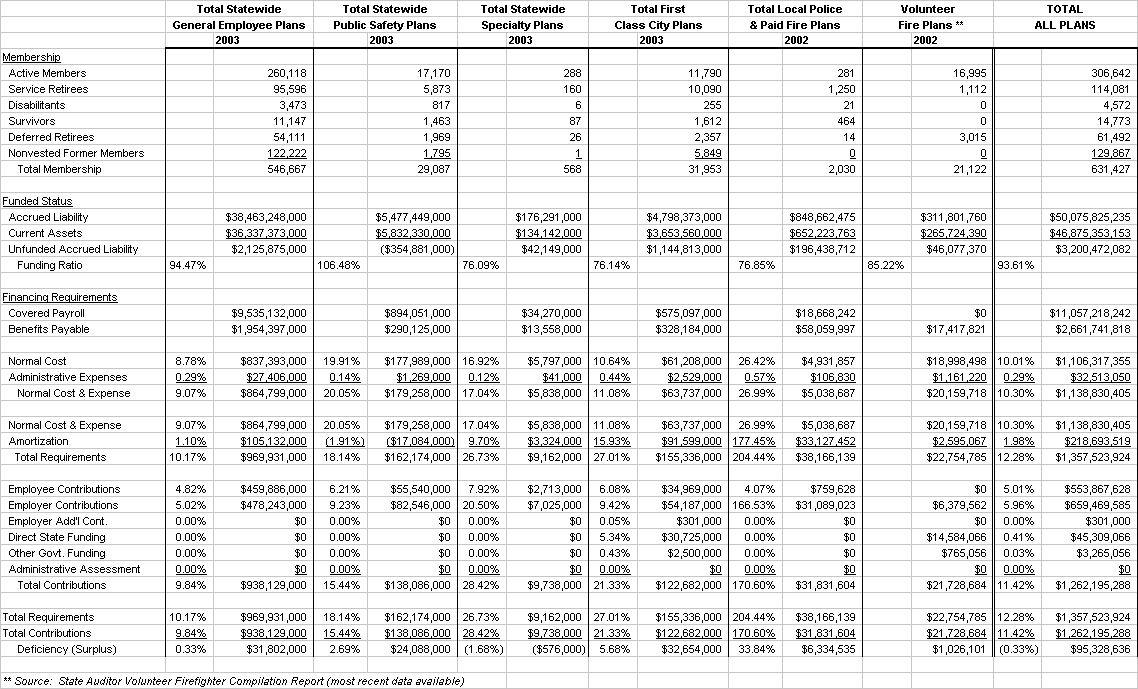
Actuarial
Valuation Results Summary, Statewide General Employee Plans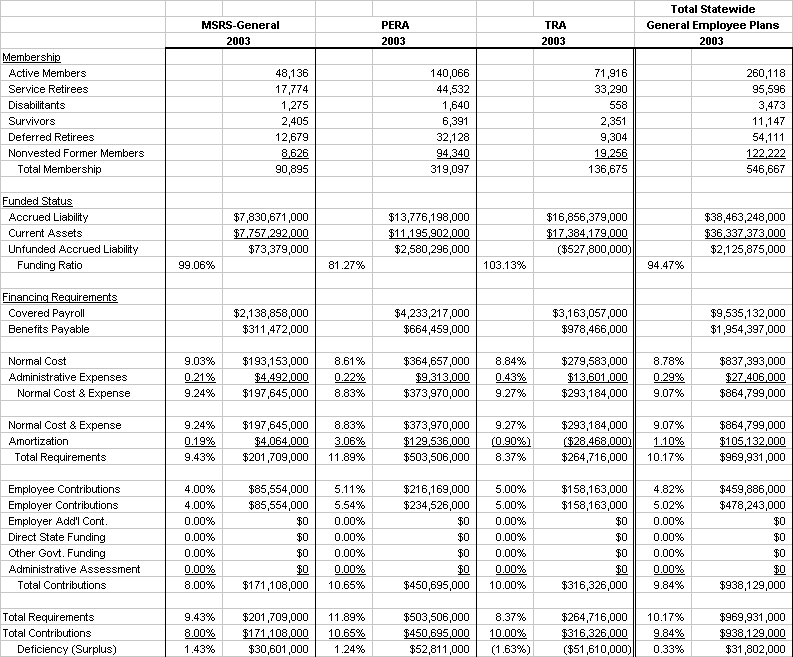
Actuarial Valuation Results Summary, Statewide Public Safety
Plans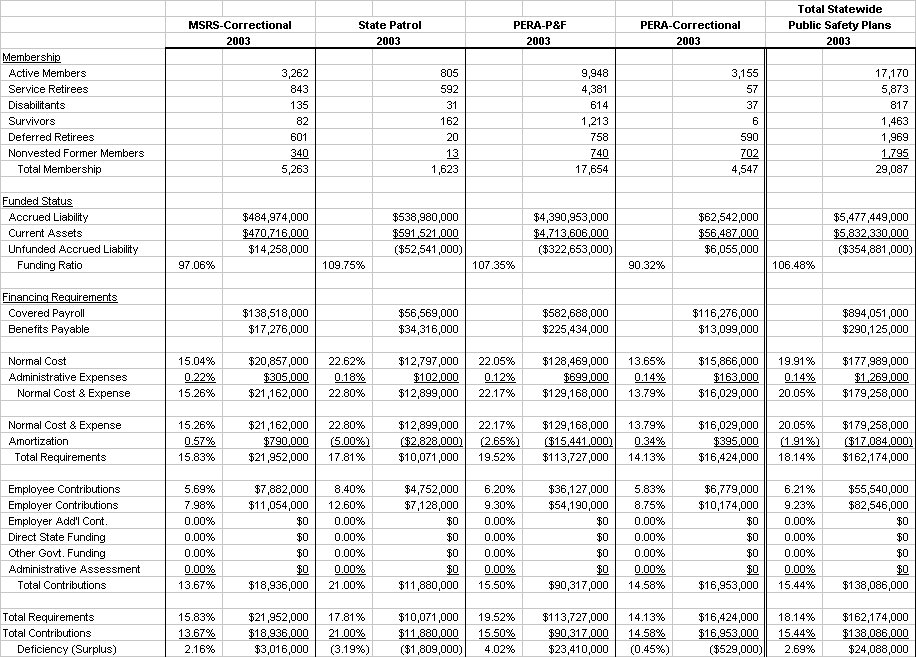
Actuarial Valuation Results Summary, Local Police and Paid Fire Plans
|
|
|
|
|
|
|
|
|
|
|
|
Total
Local Police |
|
|
|
|
|
|
|
Virginia
Fire |
and
Paid Fire Plans |
||||||
|
|
2002
|
2002
|
2002
|
2002
|
2002
|
2002
|
||||||
|
Membership |
|
|
|
|
|
|
|
|
|
|
|
|
|
Active
Members |
|
152
|
|
0
|
|
76
|
|
53
|
|
0
|
|
281
|
|
Service
Retirees |
|
115
|
|
11
|
|
436
|
|
674
|
|
14
|
|
1,250
|
|
Disabilitants |
|
12
|
|
0
|
|
8
|
|
0
|
|
1
|
|
21
|
|
Survivors |
|
14
|
|
3
|
|
190
|
|
254
|
|
3
|
|
464
|
|
Deferred
Retirees |
|
9
|
|
0
|
|
2
|
|
3
|
|
0
|
|
14
|
|
Nonvested
Former Members |
|
0
|
|
0
|
|
-- |
|
0
|
|
0
|
|
0
|
|
Total Membership |
|
302
|
|
14
|
|
712
|
|
984
|
|
18
|
|
2,030
|
|
|
|
|
|
|
|
|
|
|
|
|
|
|
|
Funded Status |
|
|
|
|
|
|
|
|
|
|
|
|
|
Accrued
Liability |
|
$81,361,778
|
|
$7,830,552
|
|
$292,677,962
|
|
$463,486,555
|
|
$3,305,628
|
|
$848,662,475
|
|
Current
Assets |
|
$78,447,409
|
|
$6,431,374
|
|
$255,194,400
|
|
$309,667,154
|
|
$2,483,426
|
|
$652,223,763
|
|
Unfunded
Accrued Liability |
|
$2,914,369
|
|
$1,399,178
|
|
$37,483,562
|
|
$153,819,401
|
|
$822,202
|
|
$196,438,712
|
|
Funding Ratio |
96.42%
|
|
82.10%
|
|
87.19%
|
|
66.80%
|
|
75.10%
|
|
76.85%
|
|
|
|
|
|
|
|
|
|
|
|
|
|
|
|
|
Financing Requirements |
|
|
|
|
|
|
|
|
|
|
|
|
|
Covered
Payroll |
|
$9,172,896
|
|
$0
|
|
$5,539,933
|
|
$3,955,413
|
|
$0
|
|
$18,668,242
|
|
Benefits
Payable |
|
$2,445,360
|
|
$454,858
|
|
$24,064,274
|
|
$30,724,261
|
|
$371,244
|
|
$58,059,997
|
|
|
|
|
|
|
|
|
|
|
|
|
|
|
|
Normal
Cost |
31.84%
|
$2,921,050
|
|
$0
|
21.74%
|
$1,157,861
|
21.56%
|
$852,946
|
|
$0
|
26.42%
|
$4,931,857
|
|
Administrative
Expenses |
0.94%
|
$86,558
|
|
$20,272
|
0.00%
|
-- |
0.00%
|
-- |
|
$0
|
0.57%
|
$106,830
|
|
Normal Cost & Expense |
32.79%
|
$3,007,608
|
|
$20,272
|
21.74%
|
$1,157,861
|
21.56%
|
$852,946
|
|
$0
|
26.99%
|
$5,038,687
|
|
|
|
|
|
|
|
|
|
|
|
|
|
|
|
Normal
Cost & Expense |
32.79%
|
$3,007,608
|
|
$20,272
|
21.74%
|
$1,157,861
|
21.56%
|
$852,946
|
|
$0
|
26.99%
|
$5,038,687
|
|
Amortization |
4.68%
|
$429,215
|
|
$230,291
|
114.34%
|
$6,334,535
|
657.19%
|
$25,994,756
|
|
$138,655
|
177.45%
|
$33,127,452
|
|
Total
Requirements |
37.46%
|
$3,436,823
|
|
$250,563
|
136.08%
|
$7,492,396
|
678.75%
|
$26,847,702
|
|
$138,655
|
204.44%
|
$38,166,139
|
|
|
|
|
|
|
|
|
|
|
|
|
|
|
|
Employee
Contributions |
0.00%
|
$0
|
|
$0
|
8.00%
|
$443,195
|
8.00%
|
$316,433
|
|
$0
|
4.07%
|
$759,628
|
|
Employer
Contributions |
37.46%
|
$3,436,823
|
|
$250,563
|
13.74%
|
$731,713
|
670.75%
|
$26,531,269
|
|
$138,655
|
166.53%
|
$31,089,023
|
|
Employer
Add'l Cont. |
0.00%
|
$0
|
|
$0
|
--
|
--
|
--
|
--
|
|
$0
|
0.00%
|
$0
|
|
Direct
State Funding |
0.00%
|
$0
|
|
$0
|
--
|
--
|
--
|
--
|
|
$0
|
0.00%
|
$0
|
|
Other
Govt. Funding |
0.00%
|
$0
|
|
$0
|
--
|
--
|
--
|
--
|
|
$0
|
0.00%
|
$0
|
|
Administrative
Assessment |
0.00%
|
$0
|
|
$0
|
-- |
-- |
-- |
-- |
|
$0
|
0.00%
|
$0
|
|
Total Contributions |
37.46%
|
$3,436,823
|
|
$250,563
|
21.74%
|
$1,157,861
|
678.75%
|
$26,847,702
|
|
$138,655
|
170.60%
|
$31,831,604
|
|
|
|
|
|
|
|
|
|
|
|
|
|
|
|
Total Requirements |
37.46%
|
$3,436,823
|
|
$250,563
|
136.08%
|
$7,492,396
|
678.75%
|
$26,847,702
|
|
$138,655
|
204.44%
|
$38,166,139
|
|
Total Contributions |
37.46%
|
$3,436,823
|
|
$250,563
|
21.74%
|
$1,157,861
|
678.75%
|
$26,847,702
|
|
$138,655
|
170.60%
|
$31,831,604
|
|
Deficiency (Surplus) |
0.00%
|
$0
|
|
$0
|
114.34%
|
$6,334,535
|
0.00%
|
$0
|
|
$0
|
33.84%
|
$6,334,535
|
Actuarial
Valuation Results Summary, Statewide Specialty Retirement Plans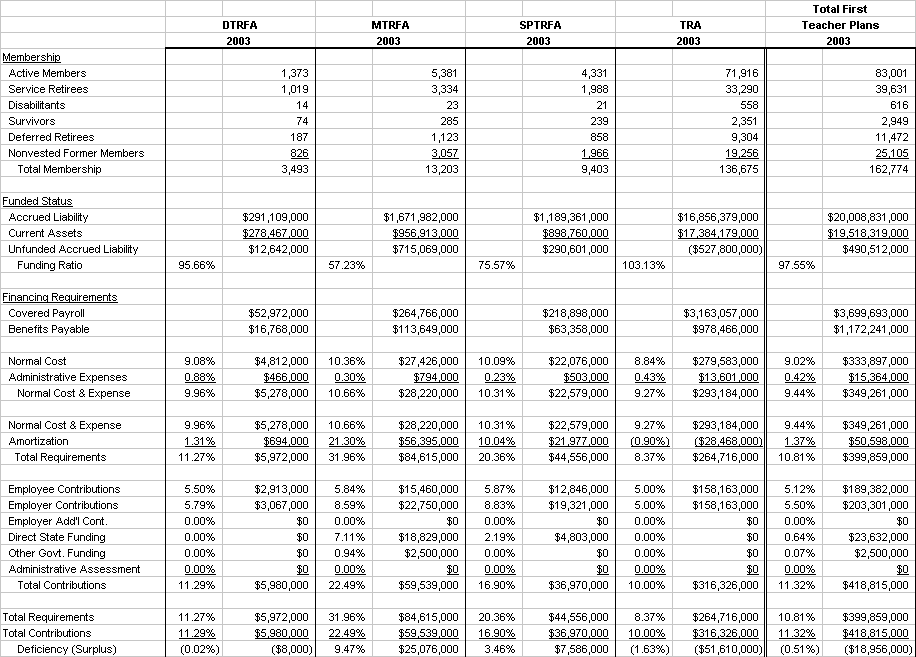
Actuarial Valuation Results Summary, First Class City Retirement
Plans
Actuarial Valuation Results Summary, Teacher Retirement Plans (1st Class Cities
TRA)
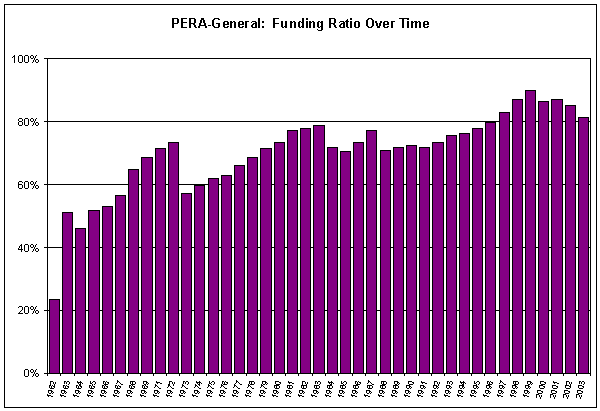
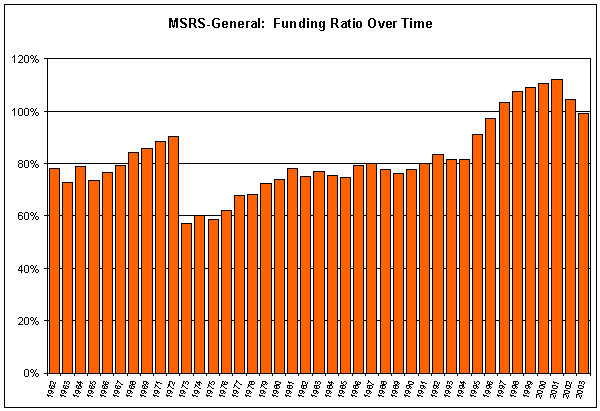
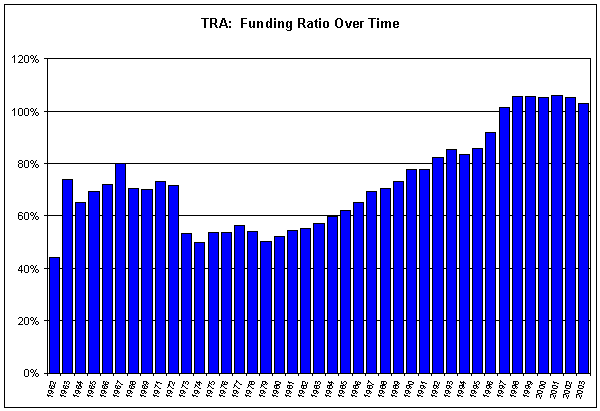
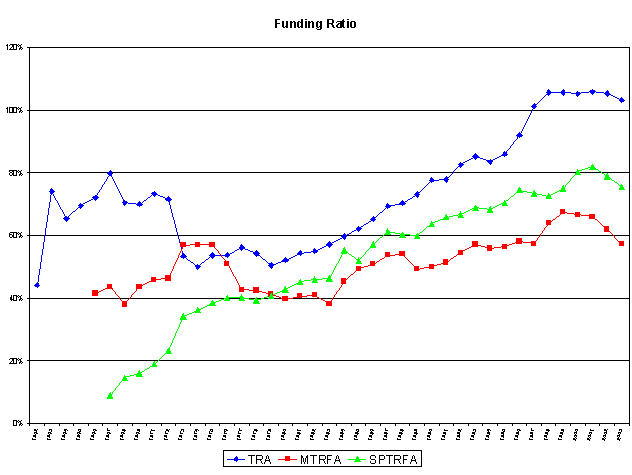
Normal Cost as a Percentage of
Payroll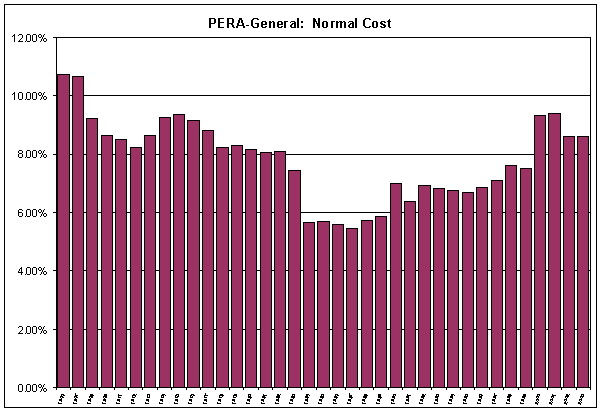
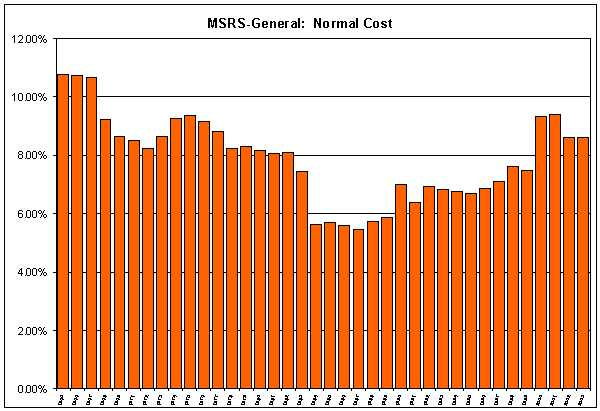
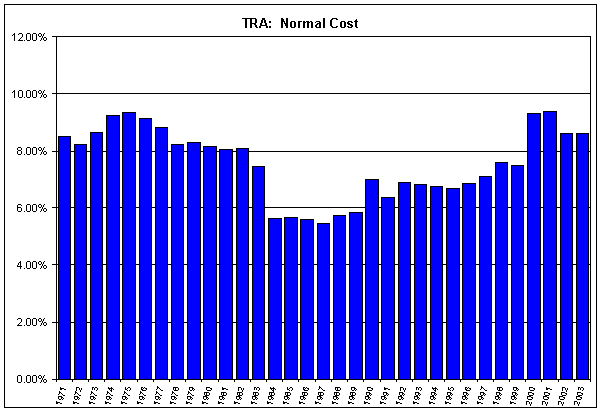
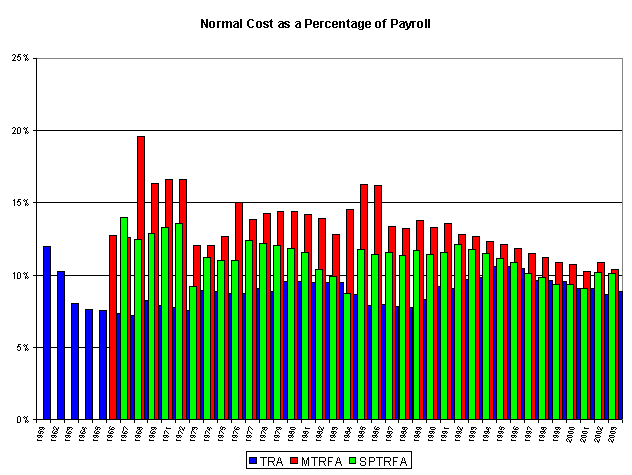
Employee and Employer
Contributions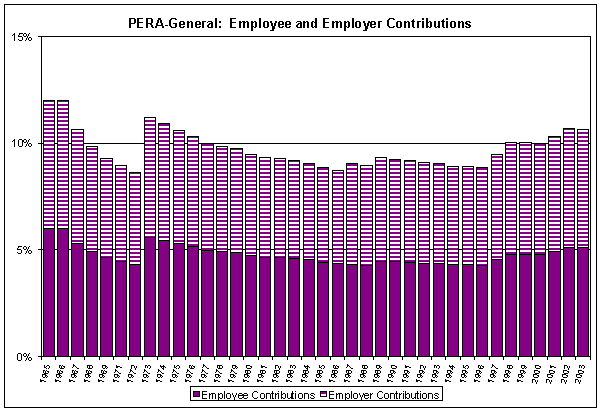
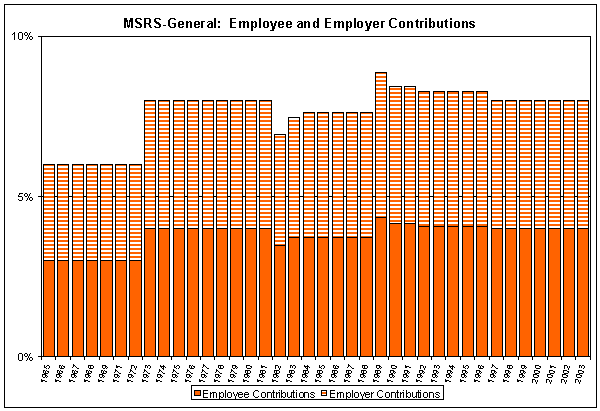
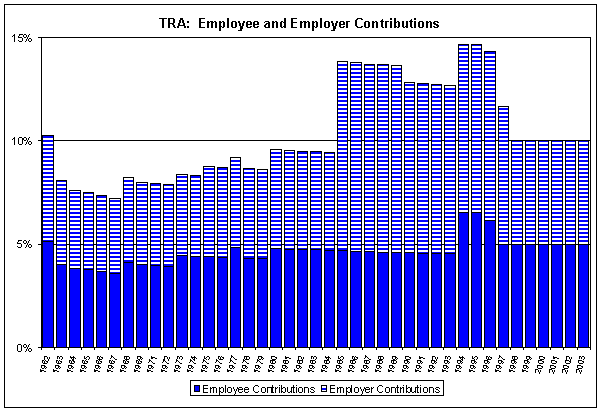
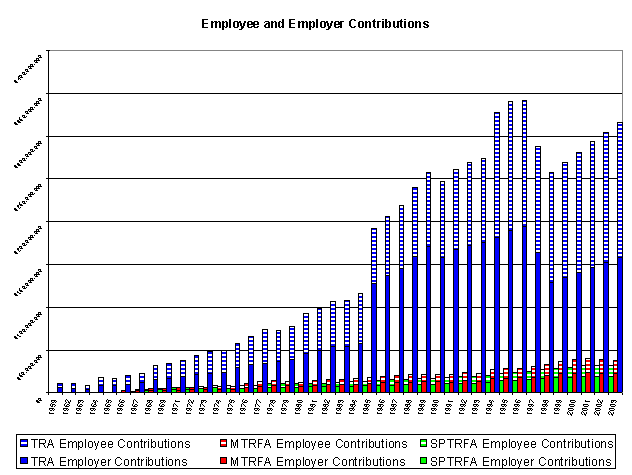
Total Requirements vs. Total
Support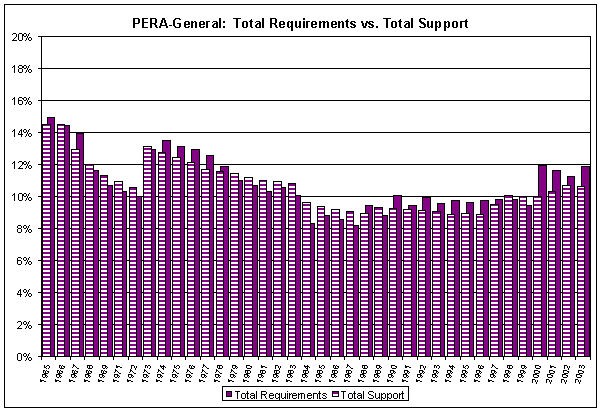
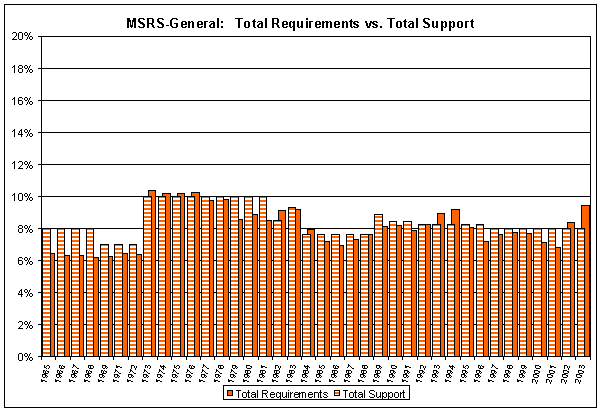
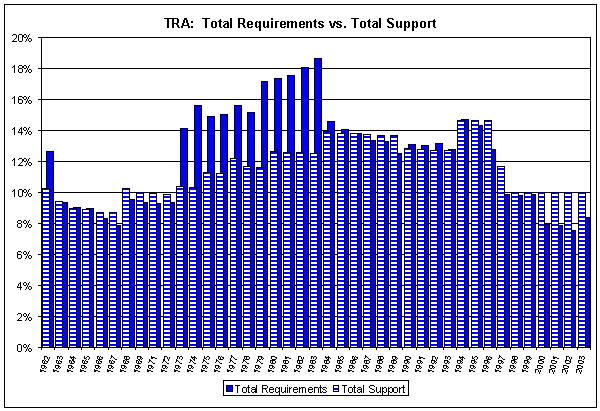
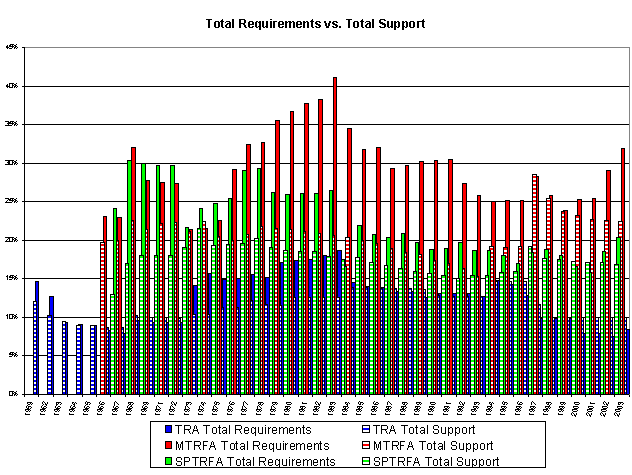
Minnesota Public Pension Plans: Funding Progress 1957-2003
|
|
General State Employees Plan (MSRS) |
Major Three Plans (MSRS, PERA, TRA |
Minneapolis Teachers Retirement Fund Association (MTRFA) |
First Class City Teacher Retirement Fund Associations |
All Plans |
|||||
|
1957: |
Actuarial Accrued Liability |
|
$69,000,000 |
|
$291,738,421 |
|
$63,923,400 |
|
$99,349,200 |
|
$564,829,533 |
|
Assets |
|
$42,300,000 |
|
$107,088,150 |
|
$26,517,000 |
|
$35,596,700 |
|
$177,900,430 |
|
Unfunded Accrued Liability |
|
$26,700,000 |
|
$184,650,271 |
|
$37,406,400 |
|
$63,752,500 |
|
$386,929,103 |
|
Funding Ratio |
61.30% |
|
36.71% |
|
41.48% |
|
35.83% |
|
31.50% |
|
|
|
|
|
|
|
|
|
|
|
|
|
|
Normal Cost |
6.29% |
$5,289,890 |
9.03% |
$26,414,703 |
12.75% |
$2,023,700 |
13.17% |
$3,800,800 |
9.37% |
$34,192,946 |
|
Expenses |
-- |
-- |
0.07% |
$193,895 |
-- |
-- |
-- |
-- |
0.05% |
$193,895 |
|
Amortization |
1.37% |
$1,152,170 |
11.61% |
$7,345,006 |
3.19% |
$506,300 |
5.63% |
$1,625,300 |
3.92% |
$14,306,194 |
|
Financial Requirements |
7.66% |
$6,442,060 |
20.71% |
$33,953,604 |
15.94% |
$2,530,000 |
18.80% |
$5,426,100 |
13.34% |
$48,693,035 |
|
|
|
|
|
|
|
|
|
|
|
|
|
Member Contributions |
3.00% |
$2,523,000 |
5.14% |
$15,024,358 |
6.00% |
$952,300 |
5.76% |
$1,662,800 |
5.17% |
$18,881,196 |
|
Employer Contributions |
5.00% |
$4,205,000 |
6.69% |
$19,557,757 |
13.72% |
$2,177,700 |
11.29% |
$3,258,000 |
7.38% |
$26,931,655 |
|
Total Contributions |
8.00% |
$6,728,000 |
11.83% |
$34,582,115 |
19.72% |
$3,130,000 |
17.05% |
$4,920,800 |
12.55% |
$45,812,851 |
|
|
|
|
|
|
|
|
|
|
|
|
|
1975: |
Actuarial Accrued Liability |
|
$429,700,000 |
|
$2,286,800,000 |
|
$177,235,900 |
|
$330,125,800 |
|
$3,406,858,458 |
|
Assets |
|
$255,800,000 |
|
$1,311,400,000 |
|
$101,094,100 |
|
$173,018,400 |
|
$1,799,398,021 |
|
Unfunded Accrued Liability |
|
$173,900,000 |
|
$975,400,000 |
|
$76,141,800 |
|
$157,107,400 |
|
$1,607,460,437 |
|
Funding Ratio |
59.50% |
57.30% |
57.04% |
52.40% |
52.80% |
|
||||
|
|
|
|
|
|
|
|
|
|
|
|
|
Normal Cost |
6.91% |
$26,486,000 |
8.53% |
$138,946,000 |
12.65% |
$7,201,500 |
10.24% |
$13,105,500 |
9.92% |
$196,674,000 |
|
Expenses |
0.14% |
$537,000 |
0.12% |
$1,981,000 |
0.52% |
$296,000 |
0.38% |
$481,700 |
0.15% |
$2,916,000 |
|
Amortization |
3.11% |
$11,921,000 |
4.46% |
$72,751,000 |
9.44% |
$5,374,000 |
8.99% |
$11,503,900 |
5.97% |
$118,440,000 |
|
Financial Requirements |
10.16% |
$38,944,000 |
13.11% |
$213,678,000 |
22.61% |
$12,871,500 |
19.61% |
$25,091,100 |
16.04% |
$318,030,000 |
|
|
|
|
|
|
|
|
|
|
|
|
|
Member Contributions |
4.00% |
$15,332,000 |
4.62% |
$75,244,000 |
6.50% |
$3,700,400 |
6.08% |
$7,773,300 |
5.02% |
$99,459,000 |
|
Employer Contributions |
6.00% |
$22,998,000 |
6.57% |
$107,066,000 |
14.03% |
$7,987,000 |
10.67% |
$13,645,800 |
8.78% |
$174,017,000 |
|
Total Contributions |
10.00% |
$38,330,000 |
11.19% |
$182,310,000 |
20.53% |
$11,687,400 |
16.75% |
$21,419,100 |
13.80% |
$273,476,000 |
|
|
|
|
|
|
|
|
|
|
|
|
|
1992: |
Actuarial Accrued Liability |
|
$3,125,299,000 |
|
$16,227,774,000 |
|
$840,840,000 |
|
$1,498,845,000 |
|
$21,696,883,910 |
|
Assets |
|
$2,613,472,000 |
|
$12,916,315,000 |
|
$457,978,000 |
|
$930,468,000 |
|
$16,182,748,253 |
|
Unfunded Accrued Liability |
|
$511,827,000 |
|
$3,311,459,000 |
|
$382,862,000 |
|
$568,377,000 |
|
$5,514,135,657 |
|
Funding Ratio |
83.62% |
|
79.59% |
|
54.47% |
|
62.08% |
|
74.59% |
|
|
|
|
|
|
|
|
|
|
|
|
|
|
Normal Cost |
6.58% |
$109,348,000 |
7.78% |
$484,644,000 |
12.81% |
$18,672,800 |
12.01% |
$37,593,700 |
8.95% |
$635,565,597 |
|
Expenses |
0.23% |
$3,815,000 |
0.31% |
$19,386,000 |
2.16% |
$3,148,600 |
1.51% |
$4,726,600 |
0.42% |
$29,673,009 |
|
Amortization |
1.46% |
$24,218,000 |
2.49% |
$155,114,000 |
12.46% |
$18,162,600 |
8.62% |
$26,972,900 |
3.37% |
$239,396,412 |
|
Financial Requirements |
8.27% |
$137,381,000 |
10.58% |
$659,144,000 |
27.43% |
$39,984,000 |
22.14% |
$69,293,200 |
12.74% |
$904,635,018 |
|
|
|
|
|
|
|
|
|
|
|
|
|
Member Contributions |
4.07% |
$67,512,000 |
4.35% |
$271,099,000 |
6.64% |
$9,678,900 |
6.22% |
$19,454,200 |
4.72% |
$335,020,962 |
|
Employer Contributions |
4.20% |
$69,669,000 |
5.76% |
$358,409,000 |
9.69% |
$14,124,900 |
8.77% |
$27,452,300 |
7.28% |
$517,346,923 |
|
Total Contributions |
8.27% |
$137,181,000 |
10.11% |
$629,508,000 |
16.33% |
$23,803,800 |
14.99% |
$46,906,500 |
12.00% |
$852,367,885 |
|
|
|
|
|
|
|
|
|
|
|
|
|
2003: |
Actuarial Accrued Liability |
|
$7,830,671,000 |
|
$38,463,248,000 |
|
$1,671,982,000 |
|
$3,152,452,000 |
|
$50,077,427,255 |
|
Assets |
|
$7,757,292,000 |
|
$36,337,373,000 |
|
$956,913,000 |
|
$2,134,140,000 |
|
$46,877,353,153 |
|
Unfunded Accrued Liability |
|
$73,379,000 |
|
$2,125,875,000 |
|
$715,069,000 |
|
$1,018,312,000 |
|
$3,200,074,102 |
|
Funding Ratio |
99.06% |
|
94.47% |
|
57.23% |
|
67.70% |
|
93.61% |
|
|
|
|
|
|
|
|
|
|
|
|
|
|
Normal Cost |
9.03% |
$193,153,000 |
8.78% |
$837,393,000 |
10.36% |
$27,426,000 |
10.21% |
$54,314,000 |
10.01% |
$1,106,317,400 |
|
Expenses |
0.21% |
$4,492,000 |
0.29% |
$27,406,000 |
0.30% |
$794,000 |
0.33% |
$1,763,000 |
0.29% |
$32,513,100 |
|
Amortization |
0.19% |
$4,064,000 |
1.10% |
$105,132,000 |
21.30% |
$56,395,000 |
14.73% |
$79,066,000 |
1.98% |
$218,713,500 |
|
Financial Requirements |
9.43% |
$201,709,000 |
10.17% |
$969,931,000 |
31.96% |
$84,615,000 |
25.27% |
$135,143,000 |
12.28% |
$1,357,544,000 |
|
|
|
|
|
|
|
|
|
|
|
|
|
Member Contributions |
4.00% |
$85,554,000 |
4.82% |
$459,886,000 |
5.84% |
$15,460,000 |
5.82% |
$31,219,000 |
5.01% |
$553,867,600 |
|
Employer Contributions |
4.00% |
$85,554,000 |
5.02% |
$478,243,000 |
8.59% |
$22,750,000 |
8.41% |
$45,138,000 |
5.96% |
$659,469,600 |
|
Direct State Funding |
0.00% |
$0 |
0.00% |
$0 |
7.11% |
$18,829,000 |
4.40% |
$23,632,000 |
0.41% |
$45,309,100 |
|
Other Govt. Funding |
0.00% |
$0 |
0.00% |
$0 |
0.94% |
$2,500,000 |
0.47% |
$2,500,000 |
0.03% |
$3,265,100 |
|
Administrative Assessment |
0.00% |
$0 |
0.00% |
$0 |
0.00% |
$0 |
0.00% |
$0 |
0.00% |
$0 |
|
Total Contributions |
8.00% |
$171,108,000 |
9.84% |
$938,129,000 |
22.48% |
$59,539,000 |
19.10% |
$102,789,000 |
11.41% |
$1,261,911,400 |
Minnesota Public Pension Plans
Actuarial Experience Gains (-) and Losses (+)
(1986-2003)
Salary
Increase Assumption
The Retirement Plan Watch List
As Reported by Milliman USA, the
Consulting Actuarial Firm Retained by the
Legislative Commission on Pensions and Retirement (2/10/2004)
In order of the severity of the problem and
the need for corrective action
Retirement Plans With Current Funding Problems:
|
Plan |
Funding Ratio/1 |
Contribution |
|
Minneapolis Teachers Retirement Fund Association |
58.97% |
9.47% |
|
Public Employees Police and Fire Plan |
111.10% |
4.02% |
|
St. Paul Teachers Retirement Fund Association |
79.00% |
3.46% |
|
MSRS-Correctional State Employees Retirement Plan |
105.62% |
2.16% |
|
MSRS-General State Employees Retirement Plan |
105.49% |
1.43% |
|
PERA-General Employees Retirement Plan |
86.94% |
1.24% |
Retirement Plans Without Current Funding Problems:
|
Plan |
Funding Ratio/1 |
Contribution |
|
Minneapolis Employees Retirement Fund |
93.44% |
(0.01%) |
|
Duluth Teachers Retirement Fund Association |
99.65% |
(0.02%) |
|
PERA-Local Correctional Retirement Plan |
101.05% |
(0.45%) |
|
Teachers Retirement Association |
110.59% |
(1.63%) |
|
Judges Retirement Plan |
79.85% |
(1.69%) |
|
State Patrol |
119.01% |
(3.19%) |
Source: 7/1/2003 Actuarial Valuations and Summary of 2003 Valuations, Milliman USA
Notes:
/1
The actuarial value of plan assets expressed as a percentage of the actuarial accrued liability of the plan./2
The difference between the total actuarial requirements of the plan and the total contributions and other remaining support, expressed as a percentage of covered payroll.

The State of Minnesota has established 16 different aid programs dedicated to or specifically applicable to public employee retirement plans.
The aid programs are:
Fire State Aid;
Minimum Volunteer Firefighter Fire State Aid;
First Class City Fire Insurance Premium Tax Surcharge;
Police State Aid;
Local Police and Paid Fire Relief Association Amortization Aid;
Supplemental Police and Paid Fire Amortization State Aid;
Additional Amortization State Aid;
Minneapolis Employees Retirement Fund (MERF) State Contribution;
Volunteer Fire Lump Sum Supplemental Benefit State Reimbursement;
Pre-1974 Retiree MERF Special Post Retirement Adjustment Aid;
Teacher Retirement Plan State Categorized Aid and State Funding;
1993 State Supplemental MTRFA/SPTRFA Contributions;
1996 State Supplementary MTRFA/SPTRFA Contributions;
1997 State Supplemental First Class City Teacher Retirement Fund Association Funding;
1997 State Aid for the PERA-General Employer Contribution Rate Increase; and
Ambulance Service Personnel Longevity Award and Incentive State Aid.
The following summarizes these aid programs, specifying their governing statutes, the establishment year, the source of the aid, the aid recipient or recipients, and the recent total aid amounts:
|
State Aid Program |
Governing Statute |
Year
In Which Aid Program |
Aid Source |
Aid Recipient(s) |
Recent
Total Aid |
|
1. Fire State Aid |
Minnesota Statutes, Sections 69.011 to 69.051 |
1885 |
State General Fund (Dedicated proceeds of equivalent to two percent insurance premium tax) |
Municipalities and nonprofit firefighting corporations with fire department with at least 10 firefighters |
2000: $16,055,136 |
|
2. Minimum Volunteer Firefighter Fire State Aid |
Minnesota Statutes, Sections 69.021, Subdivision 7, Paragraph (d), and 423A.02, Subdivision 3, Paragraph (e) |
1996 |
30 percent of excess amortization and supplemental amortization state aid freed up by fully funded relief associations or consolidation accounts |
Municipalities and nonprofit firefighting corporations eligible to receive fire state aid |
2000: $1,210,366 |
|
3. First Class City Fire Insurance Premium Tax Surcharge |
Minnesota Statutes, Section 297I.10 |
1934 |
State General Fund (Dedicated proceeds of two percent of fire insurance premium amount in Duluth, Minneapolis, and St. Paul) |
Duluth (approx. 13%) |
2000: $1,092,207 |
|
4. Police State Aid |
Minnesota Statutes, Sections 69.011 to 69.051 |
1971 |
State General Fund (Dedicated proceeds of equivalent to two percent insurance premium tax) |
Counties, cities, townships, the Metropolitan Airports Commission, Indian tribal governments, the Dept. of Public Safety, and the Dept. of Natural Resources. |
2000: $45,915,460 |
|
5. Local Police and Paid Fire Relief Association Amortization State Aid |
Minnesota Statutes, Section 423A.02, Subdivision 1 |
1980 |
State General Fund |
Cities with local police or paid firefighter relief associations |
2000: $1,639,219 |
|
6. Supplemental Police and Paid Fire Amortization State Aid |
Minnesota Statutes, Section 423A.02, Subdivision 1a |
1984 |
State General Fund |
Cities with local police or paid firefighter relief associations |
2000: $529,703 |
|
7. Additional Amortization State Aid |
Minnesota Statutes, Section 423A.02, Subdivision 1b |
1995 |
State General Fund (one-half of excess police state aid after ambulance longevity award program deduction) |
Cities with local police or paid firefighter relief associations |
2000: $4,164,411 |
|
8. Volunteer Fire Lump Sum Supplemental Benefit State Reimbursement |
Minnesota Statutes, Section 424A.10 |
1988 |
State General Fund (line item appropriation to the Dept. of Revenue) |
Volunteer firefighter relief associations paying lump sum service pensions in prior year which apply for reimbursement |
2000: $378,000 |
|
9. State Contribution to MERF |
Minnesota Statutes, Section 422A.101, Subdivision 3 |
1979 |
State General Fund |
Minneapolis Employees Retirement Fund (MERF) |
2000: $7,032,750 |
|
10. Pre-1974 MERF Retiree Special Post-Retirement Adjustment Aid |
Minnesota Statutes, Section 356.43 |
1991 |
State General Fund |
MERF |
2000: $510,647 2002: Incorporated into State contribution to MERF
|
|
11. State Funding of Teacher Retirement |
Minnesota Statutes, Sections 126C.10 to 126C.23 |
1915/ |
State General Fund |
School districts and other educational employers |
2000 2001 2002
|
|
12. 1993 State Supplemental MTRFA/SPTRFA Contributions |
Minnesota Statutes, Section 354A.12, Subdivision 3b |
1993 |
State General Fund |
Minneapolis Teachers Retirement Fund Association (MTRFA) and St. Paul Teachers Retirement Fund Association (SPTRFA) |
2000: $3,000,000 |
|
13. 1996 State Supplementary MTRFA/SPTRFA Contributions |
Minnesota Statutes, Section 423A.02, Subdivision 3 |
1996 |
State General Fund |
MTRFA and SPTRFA |
2000: $4,480,000 |
|
14. 1997 State Supplemental First Class City Teacher Retirement Fund Associations Funding |
Minnesota Statutes, Section 354A.12, Subdivision 3a |
1997 |
State General Fund |
Duluth Teachers Retirement Fund Association (DTRFA), MTRFA, and SPTRFA |
2000: $15,767,000 |
|
15. 1997 State Aid for PERA-General
|
Minnesota Statutes, Sections 124.2141 and 273.1385 |
1997 |
State General Fund |
General Employee Retirement Plan of the Public Employees Retirement Association (PERA-General) |
2000: $14,586,176 |
|
16. Ambulance Service Personnel Longevity Award and Incentive Program State Aid |
Minnesota Statutes, Sections 69.021, Subdivision 11, Paragraph (c), and 144E.42 |
1993 |
State General Fund (deduction from excess police state aid) |
Ambulance service personnel longevity award and incentive program |
2000: $1,000,000 |
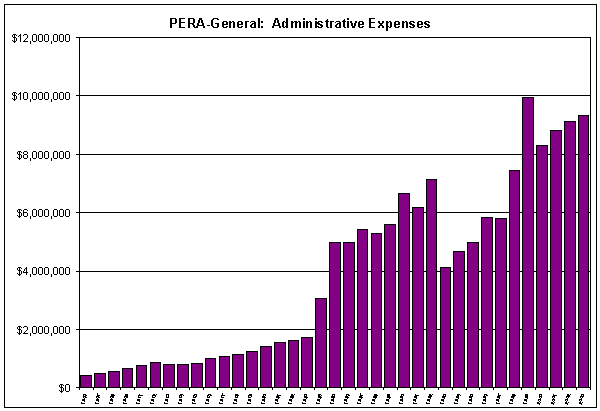
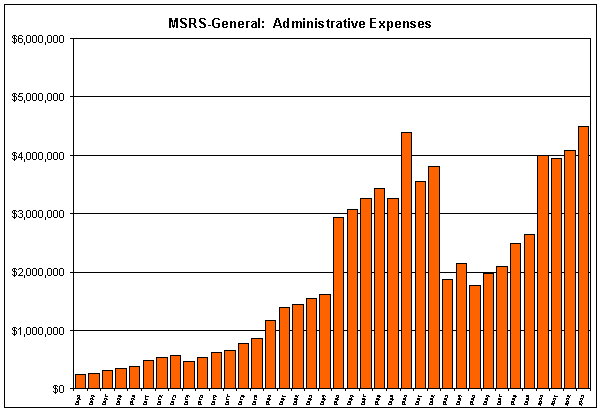
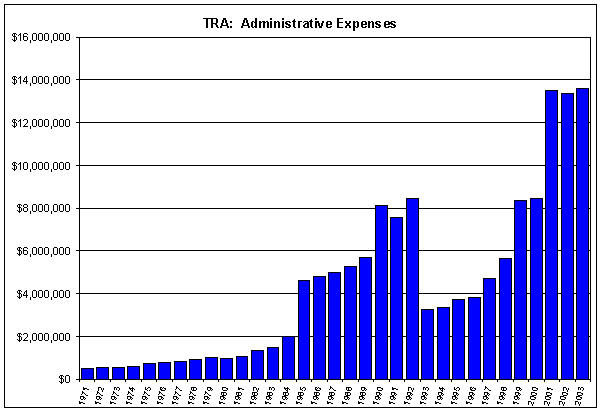
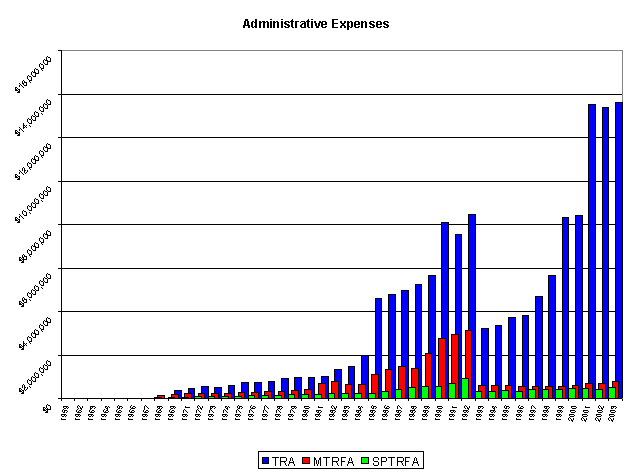
Various Minnesota Public Pension Funds:
Total Portfolio Time-Weighted Rates of Return
|
Year |
SBI Combined |
SBI Basic |
SBI Post |
MTRFA |
DTRFA |
SPTRFA |
MERF |
|
1990 |
|
-0.7% |
5.0% |
-2.5% |
3.2% |
4.6% |
-5.9% |
|
1991 |
|
26.3% |
19.6% |
25.0% |
22.0% |
19.8% |
13.3% |
|
1992 |
|
6.8% |
8.0% |
8.2% |
6.5% |
7.2% |
8.8% |
|
1993 |
|
12.2% |
11.6% |
12.3% |
12.8% |
11.3% |
13.7% |
|
1994 |
-0.4% |
|
|
0.1% |
0.2% |
0.3% |
1.2% |
|
1995 |
25.5% |
|
|
25.0% |
25.5% |
26.2% |
23.4% |
|
1996 |
15.3% |
|
|
13.6% |
13.4% |
12.6% |
12.9% |
|
1997 |
21.5% |
|
|
15.5% |
15.5% |
19.6% |
18.5% |
|
1998 |
16.1% |
|
|
14.2% |
11.1% |
12.0% |
15.7% |
|
1999 |
16.5% |
|
|
21.6% |
29.4% |
13.6% |
15.5% |
|
2000 |
-2.8% |
|
|
-6.0% |
-1.6% |
-0.2% |
-1.3% |
|
2001 |
-6.0% |
|
|
-7.7% |
-4.3% |
-1.7% |
-6.1% |
|
2002 |
-11.6% |
|
|
-16.1% |
|
|
|
|
2003* |
12.8% |
|
|
12.3% |
|
|
|
* 1/1/03-9/30/03
Approaches to Address Public Pension Plan Funding Problems:
Minnesota
Minnesota has had financially distressed pension plans in the past and has taken various actions to address those funding problems.
Approaches to address public pension plan funding problems have included:
Benefit reductions;
Closing off benefit plans to new hirees;
Employer contribution increases;
State assistance; and
Consolidations/mergers.
An outright benefit reduction was part of the aftermath of the 1931 default of the 1915 Law Teacher Retirement Plan (predecessor to TRA), when retiree benefits were reduced by one-half and the reduction was not reversed until 1957.
Benefit plans have been closed to new members in a number of instances (TRA-Basic in 1957; PERA-Basic in 1967; MTRFA-Basic in 1978; SPTRFA-Basic in 1978; MERF in 1979; DTRFA Old Law Plan in 1979; 46 local police and paid firefighter relief associations over the period 1969-1980).
Employer contributions have been increased in a number of instances (PERA employer contribution increase in 1957; local police and paid firefighter relief associations financing Guidelines Act in 1969; additional school district and/or city funding for MTRFA in 1993 and 1996).
State aid for public pension plans has been added or augmented on several occasions (State funding of TRA and first class city teacher plans from sales tax proceeds in 1967; Police State Aid in 1971; State aid to MERF in 1979; local police and paid fire relief association amortization aids in 1980, 1984, and 1996; volunteer fire lump sum supplement in 1987; MTRFA and SPTRFA State aids in 1993, 1996, and 1997; minimum volunteer fire state aid in 1996; PERA-General State aid in 1997).
Public pension plans with problematic funding have been consolidated or merged on various occasions (St. Paul Bureau of Health Retirement Plan consolidation into PERA-General in 1967; State Police Retirement Plan and Game Wardens Retirement Plan consolidation into the State Patrol Retirement Plan in 1969; Supreme Court Justices Retirement Plan, District Court Judges Retirement Plan, and Probate and County Court Judges Retirement Plan consolidation into the Uniform Judicial Retirement Plan in 1973-1978; local police and paid firefighter relief associations consolidated into PERA-P&F 1973-1999).
Approaches to Address Public Pension Plan Funding Problems:
Other States
Hawaii (2002): Amortization Requirement Change
Problem: Large increase in Hawaii Employees Retirement System employer contributions from increasing unfunded actuarial accrued liabilities.
Legislation: The amortization period for the plan was extended by 13 years.
Illinois (2003): Bonding for Employer Contributions
Problem: The State Employees Retirement System unfunded actuarial accrued liability increasing.
Legislation: $10 billion in pension obligations bonds issued to pay the annual state contribution and to reduce the plan unfunded actuarial accrued liability.
Kansas (2003): Bonding to Reduce Unfunded Liabilities
Problem: Large unfunded actuarial accrued liabilities increased from the transfer of higher education employees to the Public Employees Retirement System and from a converted "13th check" benefit.
Legislation: $540 million in revenue bonds issued to reduce unfunded actuarial accrued liabilities.
Maine (2001): Minimum Employer Contribution
Problem: Variable employer amortization contributions to the Maine State Retirement System.
Legislation: State contribution to amortize the unfunded actuarial accrued liability in the previous year is minimum amount for successive year.
New Jersey (2003): Bonding for Unfunded Liabilities
Problem: Unfunded actuarial accrued liabilities in the State Retirement System for 1991 and 1993 local government early retirement incentives causing large local government contributions.
Legislation: Local governments participating in the statewide retirement plan are allowed to refinance their unfunded actuarial accrued liabilities from early retirement incentives by issuing refunding bonds.
New York (2003): Bonding for Employer Contributions
Problem: State and Local Retirement Plan employer contributions were variable and growing in recent years.
Legislation: A minimum employer contribution rate was established, without ability to be suspended during good investment performance periods, and bonding for employer contributions in excess of 7 percent of pay was permitted.
Oregon (2003): Pension Plan Restructuring
Problem: Public Employee Retirement System unfunded actuarial accrued liability grew from $1 billion to $15 billion in three years due to outdated actuarial assumptions and Variable Annuity guaranteed investment return.
Legislation: Old plan was closed to new entrants, who were covered by a new benefit tier, the Variable Annuity program was closed to additional contributions, and more current actuarial assumptions implemented.
Pennsylvania (1984): Financially Distressed Municipal Pension System Recovery Program
Problem: Over 2,200 local government pension plans with various funding levels, including the Pittsburgh Public Pension Plan with a 0.09 percent funded ratio and the Pittsburgh Fire Pension Plan with a 0.16 percent funded ratio in 1982.
Legislation: For local government plans, comparable actuarial reporting was required, minimum funding requirements were based on the actuarial reporting, an existing state aid program was revised to allocate amounts more consistent with plan cost, and a recovery program was established for plans and municipalities determined to be financially distressed that involved an aggregation of pension trusts, increasing member contributions to a minimum level, exempting employers from statutory contribution limits, requiring the establishment of a new benefit plan for new employees, adding additional special taxing authority, phasing-in the implementation of the funding standards, extending the amortization period, requiring the formulation of a plan for administrative improvements, a $35 million assistance account was established for allocation on the basis of relative distress, and providing emergency loans from the assistance account to avoid defaults.
Pennsylvania (2002): Variable Employer Contributions
Problem: State Employees Retirement System employer contributions became too variable.
Legislation: Employer contribution set based on system funding experience, but with a minimum contribution amount.
Virginia (2004 Proposal): Consolidated Contribution Rates
Problem: Virginia Retirement System employer contribution rates for teachers doubled after period of decrease.
Proposal: Permit local governments to consolidate higher teacher and lower general employee contribution rates.
West Virginia (1991): Teacher Retirement Coverage Restructuring
Problem: The unfunded actuarial accrued liability and the cost of the Teachers Retirement Plan were growing.
Legislation: The defined benefit plan was closed to new entrants and a defined contribution was created, with existing members allowed to transfer to the new plan, the amortization period was extended to 40 years, an additional state contribution was provided, and the issuance of pension obligation bonds were authorized.
West Virginia (2003): Retirement Liability Bonding
Problem: Unfunded actuarial accrued liabilities growing in teacher, state trooper, and judges retirement plans.
Legislation: $3.9 billion in bonding authorized (not implemented pending the result of litigation over its constitutionality).
Source: Except for the information on the Pennsylvania 1984 legislation, the summaries presented were derived from information provided by Ron Snell of the National Conference of State Legislatures.
Information on the Pennsylvania 1984 legislation was provided by the Pennsylvania Public Employee Retirement Commission.